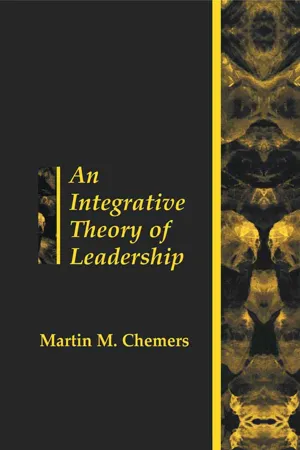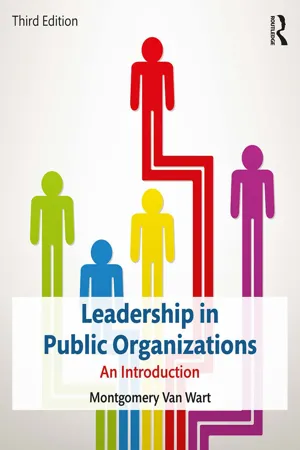Business
Transformational Leadership
Transformational leadership is a style that inspires and motivates employees to achieve exceptional results by creating a vision for the future and encouraging innovation and change. Leaders who employ this approach often focus on developing and empowering their team members, fostering a culture of continuous improvement and growth within the organization.
Written by Perlego with AI-assistance
Related key terms
Related key terms
1 of 4
Related key terms
1 of 3
12 Key excerpts on "Transformational Leadership"
- eBook - ePub
Accelerating Change in Schools
Leading Rapid, Successful, and Complex Change Initiatives
- Linda Dudar, Shelleyann Scott, Donald E. Scott(Authors)
- 2017(Publication Date)
- Emerald Publishing Limited(Publisher)
4.1.2. Transformational Leadership
The term Transformational Leadership was initially coined by Downton (1973, cited in Northouse, 2016) with the concept being further expanded and refined by urns (1978) and ass (2000, 2008). Unlike many transactional leadership models that focus on changing structures or focus on the exchange or bargaining between leaders and followers, Transformational Leadership revolves around change and the transformation of people. Its popularity as a leadership approach is due to its power to motivate and engage followers in development and change. Its central focus is on “emotions, values, ethics, standards, and long-term goals” (Northouse, 2016, p. 161). Through skilled leadership, which frequently encompasses charismatic and visionary leadership, followers will aspire to greater achievements thereby exceeding previous expectations. It overtly links leadership to follower’s needs rather than leadership with power. Transformational Leadership is characterized by idealized influence and charisma, inspirational motivation, intellectual stimulation, and individualized consideration. Idealized influence and charisma entails leaders who serve as excellent role models which encourages followers to emulate the leader. Encompassed in idealized influence is: first, the attributions that followers ascribe to leaders based on their perceptions of said leader; and second, behavior – followers’ observation of a leader’s behavior which reveals the leader’s values and priorities by what they do rather than what they say. Inspirational motivation indicates the setting of high expectations, the creation of a shared vision, and promotion of team spirit. Intellectual stimulation involves leaders’ creation of the impetus and environment to foster creativity and innovation, to challenge beliefs and values of leaders, followers, and the organization. This really is where the change in practice occurs. Individualized consideration - eBook - ePub
- Matthew Lynch(Author)
- 2012(Publication Date)
- Routledge(Publisher)
Bass (1985, 1990, 2003, 2005, & 2006) and Bruce Avolio (1990, 2003, & 2005) developed Transformational Leadership from its original theoretical concept into the formal ideology that it is today. Their work has since been improved by other scholars. According to Bass (1990), in Transformational Leadership, leaders broaden the interests of employees. They generate awareness and acceptance of the purposes and mission of the group, and stir employees to look beyond their own self-interest for the good of the group.Bass and Riggio (2006) state that the essence of Transformational Leadership lies in developing employee commitment, which then leads to the achievement of the goals and objectives of the organization. Commitment to these goals is achieved through the empowerment and motivation of employees. Transformational Leadership is concerned with relationship-building and the establishment of suitable working conditions between a leader and his or her followers. The leader must maintain an open-door policy and avoid bureaucracy. The development of a culture of trust is deemed more effective than the short-term benefits of meeting predetermined targets through coercion or rewards.Bass and Riggio (2006) identify four attributes to describe Transformational Leadership: idealized/charismatic influence, inspirational motivation, intellectual stimulation, and individualized consideration.Idealized/Charismatic Influence
This refers to a leader’s ability to inspire others in such a positive manner that he or she becomes a role model. This trait is acquired through the leader’s choice of lifestyle, language, etiquette, and mannerisms. This brand of charismatic leader usually achieves a high level of trust, since he or she leads by example and lives by his or her word.Idealized influence involves the upholding of high moral values and integrity in a leader. By so doing, it becomes easier for the leader to encourage his or her followers to forsake their self-interests for the common good of the organization’s success. A charismatic leader is also known to be adept at handling and sharing responsibility, thus making his or her leadership transformational (Avey et al., 2008). - eBook - ePub
Leadership in the Construction Industry
Developing Authentic Leaders in a Dynamic World
- George Ofori, Shamas-ur-Rehman Toor(Authors)
- 2021(Publication Date)
- Routledge(Publisher)
According to Burns, transactional leadership takes place when “one person takes the initiative in making contact with others for the purpose of an exchange of valued things” (ibid., p. 19). This type of leadership is best described as the politics of exchange, in which, for example, a public official bargains jobs for votes. Transformational Leadership, in contrast, has a moral dimension. Burns believes that Transformational Leadership occurs when “one or more persons engage with each other in such a way that leaders and followers raise one another to higher levels of motivation and morality” (ibid., p. 20). Burns defines Transformational Leadership as a dynamic, two-way relationship between leaders and followers. Leaders must connect with the needs and wants of the followers and establish motivation to accomplish collective goals that satisfy the needs of both the leader and the followers. Mutual need and empathy are the key characteristics of Transformational Leadership. He also believes that every person is engaged in the leadership process in one way or another at different times and in different situations (ibid.).In 2003, James MacGregor Burns published a follow-up book to his earlier works, entitled Transforming Leadership , to explore and expand his theory nearly 30 years after his book Leadership in 1978. He believes that all leaders have a social responsibility to empower people to pursue their own happiness by effecting social change. He states: “Leaders working as partners with the dispossessed people of the world to secure life, liberty, and the pursuit of happiness – happiness empowered with transforming purpose – could become the greatest act of united leadership the world has ever known” (Burns, 2003 , p. 4).In his (2003) book, Burns is of the opinion that a transformational leader not only speaks to immediate wants but elevates people by vesting in them a sense of possibility, a belief that change can be made, and that they can make the change. Motivation, according to Burns, is what powers leadership. Creativity is another key element of Transformational Leadership. Transforming leaders have the ability to see possibility and innovation and to share that vision with others. He believes that leaders seize opportunities, overcome obstacles, and change how the rest of the world acts, thinks, and lives. Burns believes that a crisis can often be a source of creativity. He cites examples of skillful leaders, including presidents, military commanders, and leaders of corporate organizations who have applied creativity in times of crisis to effect change. - eBook - ePub
Leadership Theory
Facilitator's Guide for Cultivating Critical Perspectives
- John P. Dugan, Natasha T. Turman, Amy C. Barnes(Authors)
- 2017(Publication Date)
- Jossey-Bass(Publisher)
Chapter 7: Theories of Transformational Leadership 7A: Transformational Leadership Marilyn J. Bugenhagen Objectives/Goals of Chapter Understand transforming and Transformational Leadership theory facilitating an awareness of power and influence dynamics. Identify foundational tenets of transforming and Transformational Leadership and interactions when considering social location. Recognize the possibilities and challenges of transforming and Transformational Leadership in the context of stocks of knowledge and ideology. Critical Concepts : authority, ideology, power, social location, stocks of knowledge Chapter Overview Transforming and Transformational Leadership are vibrant terms used across the study of leadership. Yet, through critical perspectives, they become less heroic and more focused on the influence of the reciprocal relationships between leader/followers. Burns (1978) first employed the term transforming, a verb, to describe leadership as a mutually reciprocal process between leader/followers that uplifts “one another to higher levels of motivation and morality” (p. 20). This reciprocity is described as the fusing of power bases available to both follower and leader in “mutual support for a common purpose” (p. 20). The ability to motivate one another around a common purpose for the collective good fosters strong moral and ethical engagement. Alternatively, transformational, an adjective, is presented before the word leadership. It implies related to or involving transformation, which, as a noun, describes a thorough or dramatic change in form or appearance. Transformational Leadership theory provides a view of the leader as one who engages in particular behaviors and actions with followers to promote a change in followers' performance for the purpose of organizational goals and outcomes - eBook - ePub
The Business of Leadership: An Introduction
An Introduction
- Karen Dill Bowerman, Montgomery Van Wart(Authors)
- 2014(Publication Date)
- Routledge(Publisher)
Monitoring, operations planning, clarifying roles, informing, delegating, problem-solving, consulting, personnel planning, developing staff, and motivatingEnvironmental scanning, strategic planning, vision articulation, networking, decision-making, managing organizational change as well as informing, delegating (empowering), managing innovation, consulting, developing staff, motivating, building teams, and managing personnel changeNote: Because of the tremendous variety of transactional and transformational theories, there are some exceptions to these general trends.Conclusion
Charismatic leaders have extraordinary effects on their followers. Under their leadership that brings inspiration and a strong sense of values, followers often perform at higher levels. Transformational leaders are triggers of extraordinary organizational change. Under their leadership, organizations or political and social entities may undergo significant structural change. Charismatic and Transformational Leadership frequently have agents in common, but actually the two notions are distinct. The former involves a magnetic quality of the leader and the latter involves a type of change that can be brought about by various types of leader, whether charismatic or not.Conger and Kanungo focus on how charisma is attributed to leaders. They contend that for charismatic leadership to emerge, the context has to be sufficiently problematic to allow for dissatisfaction with the status quo and for radical change to be acceptable. Charismatic leaders may be known locally or throughout a nation. Charisma can lead to positive or negative outcomes. Charismatic leadership is not for every situation. For example, charisma is not a substitute for solid management that brings continuous improvement.Tichy and Devanna focus on Transformational Leadership, with the belief that charismatic leadership is not required in order to bring about major organizational change. They examine leadership over time; before institutionalizing change, transformational leaders first recognize the need for revitalization and then create a new vision. The leadership practices theory by Kouzes and Posner is another mechanism for examining Transformational Leadership and recommending competencies or practices. By interviewing individuals on their “personal best” experiences, they advocate practices consistent with their findings—challenging the process and searching for opportunities, inspiring a shared vision, enabling others to act by fostering collaboration in a participative style, modeling the way, and, finally, “encouraging the heart” with a supportive style. - eBook - ePub
A Postcolonial Leadership
Asian Immigrant Christian Leadership and Its Challenges
- Choi Hee An(Author)
- 2020(Publication Date)
- SUNY Press(Publisher)
54 Therefore, along with their extraordinary abilities and skills, transformational leaders need to know or learn how to understand the organization, how to read the times, and how to see sociopolitical cultural values.Some scholars emphasize the importance of charisma in Transformational Leadership, others emphasize the leader’s capacity for inspiration, stimulation, and individual caring. Transformational Leadership transforms people, values, and environments. Its emphasis is to increase productivity beyond expectations. By providing charisma, inspiration, stimulation, mentoring, coaching, empowerment, and more, Transformational Leadership stresses the enhancement of communal organizational goals. Transformational leaders are expected to have superior power to lead followers on all levels and in all directions. They are expected to control the situation, change it, and challenge it by being a visionary, prophet, inspirer, supporter, mediator, facilitator, encourager, and savior of the institution and individuals at the same time. It is not clear whether transformational leaders can be trained to have these abilities. However, it is clear that transformational leaders must have these abilities and characteristics as described earlier.Feminist Leadership/Collaborative Leadership Theory Deconstructing Male Leadership and Reconstructing Women’s ExperienceThe focus of most leadership theories has been exclusively on male leaders. Studying political male leaders, male CEOs, and male religious leaders, these theories are focused on the traits, behaviors, and leadership styles of men. Female leadership theorists have begun to develop women’s leadership based on the deconstructions of male leadership and the reconstruction of female experience. For example, trait theories are primarily male-dominated leadership theories. As trait theorists recognize men born to be leaders and examine leadership only from male leaders, the traits and characteristics of leadership become male-centric. Observing only male heroes and political leaders, trait theorists misread irreconcilable images of male leaders as “the” image of leaders. Another example can be found in transactional leadership theory. Feminist theorists point out that this theory sees a clear hierarchy between leaders (who happen to be men in most cases) and followers (who happen to be women in most cases) in power by setting rewards and punishments. As long as male leaders have power to dispense rewards and punishments and create the rules themselves, the relationship between male leaders and female followers is always fraught with hierarchical power dynamics. This theory reinforces the current patriarchal structure when it reinforces the roles of transactional leaders. Many feminist theorists criticize these prominent male-centered leadership theories and analyze the problems of inequality of patriarchal power. - eBook - ePub
- Maria Stippler, Sadie Moore, Seth Rosenthal, Tina Doerffer(Authors)
- 2011(Publication Date)
- Bertelsmann Stiftung(Publisher)
coaching should be provided to help build team motivation and encourage members to process their experiences. Collaborative leadership also strives to enhance individuals’ positive social relationships.According to political scientist Robert Putnam (2000), the modern age has led to a decrease in social capital and civic engagement as a result of isolation, individualization and the breakdown of social institutions.A focus by collaborative, participatory and transformational leaders on team building, character and servant leadership may trigger a return to an idealized form of human connectedness and socially meaningful work.dp n="45" folio="50" ?3 The Development of Transformational Leadership Theory
The theory of Transformational Leadership was first described in 1978 by James McGregor Burns, and is still prominent today.Strongly influenced by the work of Bernard Bass, this approach emphasizes leadership grounded in shared visions of ethical change. It sees leadership as a process that changes and transforms leaders and followers, resulting both in increased productivity and more ethical behavior. The leader plays a central role in encouraging and inspiring meaningful change by recognizing and serving followers’ needs. Leaders and followers are thus able to work together to create a vision that serves the common good. The popularity of this theory has been attributed to its emphasis on intrinsic motivation and follower development (Bass and Riggio, 2006; Northouse, 2007).Transactional leadership
Transformational Leadership is best understood when contrasted with transactional leadership. Burns argued that the goal of transactional leadership is to meet the needs of individuals, rather than to contribute to the common good. Transactional leadership is based on a rational relationship of mutual exchange between leaders and followers and on the principle of reinforcement; followers know there will be positive or negative consequences to their behavior. Leaders are in control of the path (making things easier or more difficult) as well as of the goal (providing or withholding rewards). - eBook - ePub
Inspirational Presence
The Art of Transformational Leadership
- Jeff Evans(Author)
- 2009(Publication Date)
- Morgan James Publishing(Publisher)
CHAPTER 4—LEADING IN ORGANIZATIONS; TRANSFORMATIONAL VS. TRANSACTIONAL LEADERSHIP When the effective leader is finished with his work, the people say it happened naturally. —Lao TseYour self-definition and creativity is a fundamental of leadership. The ability of leaders to be clear about their own passions and areas of importance creates the opportunity for others to share in that direction. If you are clear about where you are going, others can be as well. This enables others to make the choice of informed action.After clarity of individual direction, leaders learn to engage others in their direction. They learn to honor choice and support change in themselves and in others. Good leadership makes it both safe and desirable for others to grow and develop. As leaders honor choice that is fueled by inspiration, they can have a very large impact across many people.To engage large numbers of people requires having an understanding of how an organization holds people together and guides collective action. It is one thing to gather a group of people who have already rallied around a cause and, through your actions, inspire them into collective movement. It is altogether different to engage a stable group of people, as in a work system or large organization, and influence them in that setting. In order to do that, you must use all the aspects of leading yourself, leading people, and leading organizations. Ultimately, you can use natural dynamics in such a way to inspire action in many people.A TALE OF TWO LEADERS
The following examples of leaders will illustrate the difference between leadership styles that are transformational and transactional. To accomplish this, we will use two fictional executives who will illustrate how these leadership style differences get lived out on a daily basis. For context, both of these are senior executives in a large corporation who have responsibility for business units. They each have seven hundred to eight hundred people in their organization, bottom-line responsibility, and operating budgets in the $100 million range. Both are experienced, highly respected, and are thought of as quite successful in their careers. Also, they are considered as clear in their written and verbal communications; literate in business, finance, and the language of their business climate; and have a solid understanding of the technical aspects of their respective businesses. Both are considered to be equally competent managers. As you read the descriptions, you will get a sense of what it is like to work in that organization and what the overall impact of their leadership must be. - eBook - ePub
Dynamics of Leadership in Public Service
Theory and Practice
- Montgomery Van Wart(Author)
- 2014(Publication Date)
- Routledge(Publisher)
Zaleznik (1977) tradition, Tichy and Devanna assert that managers are relatively commonplace but that transformational leaders are rarer and increasingly critical to organizational success. Managers are “individuals who maintain the balance of operations in an organization, relate to others according to their role, are detached, impersonal, seek solutions acceptable as a compromise among conflicting values, and identify totally with the organization” (1990, xiii). Leaders, that is, transformational-type leaders, are “individuals out to create new approaches and imagine new areas to explore; they relate to people in more intuitive and empathetic ways, seek risk where opportunity and reward are high, and project ideas into images to excite people” (ibid., xiii).The transformational leader must change organizations and people in three successive stages. The first stage is recognizing the need for revitalization. Because of the competitive environment and the speed of responsiveness required in that environment, the need for revitalization is nearly ubiquitous. The challenges and problems at this stage include making sure that environmental needs are not ignored, overcoming the innate resistance to change, and avoiding the quick fix. Individuals must disengage from the past and deal with the disenchantment of giving up past successes and comforts.The second stage is creating a new vision. New ways of doing business must be contemplated, refined, rehearsed, and widely articulated. Commitment to a new vision must be mobilized through involvement, strategic internal structuring, and excellent communication. Individuals must be encouraged to identify with the new vision, which is a combination of logical persuasion about the nature of a better future, and a leap of faith that the driving vision is accurate and realistic.The third stage is institutionalizing change. As the new vision is understood and accepted, new structures, mechanisms, and incentives must be put in place. Workable elements from the old culture must be retained, while less viable ones must be changed. The natural tendency to adjust the easy elements must be resisted, so that a more coherent and fundamental change process can be embraced. This requires a creative destruction and reweaving of the social fabric of the organization. Keeping the motivation of individuals high remains key so that they continue their inner realignment and adaptation to new internal scripts. As this takes hold for individuals, they should find new energy and overcome the debilitating effects of change. - eBook - ePub
- Martin Chemers(Author)
- 2014(Publication Date)
- Psychology Press(Publisher)
Initial and confirmatory factor analyses of responses to the measure revealed a reasonably stable factor structure that included seven leadership behavior factors that became the basis for the model (Bass, 1985). The factors fall into three categories of Transformational Leadership, transactional leadership, and nonleader-ship factors.Transformational Leadership Factors
Charisma . Charisma (idealized influence) reflects follower perceptions that the leader is extremely trustworthy and is capable of achieving an important vision. A sample item from this factor is, “Has my trust in his or her ability to overcome any obstacle.”Inspirational Motivation . This factor overlaps with charisma, but is conceptually and sometimes statistically distinct from it. This factor reflects the quality and emotional appeal of the leader’s vision rather than the degree to which the rater identifies with leader. This factor is similar to Bennis and Nanus’ (1985) concept of “shared meaning” through which the follower is induced to share the leader’s goal. A sample item from this factor is, “Uses symbols and images to focus our efforts.”A leader might be able to secure high levels of commitment from a subordinate to an inspiring vision, even if the leader is not seen as particularly gifted. Bass and Avolio (1993) compared the ability of the relatively less charismatic Lyndon Johnson and the more charismatic John Kennedy to elicit support for a visionary goal.Intellectual Stimulation . Intellectual stimulation assesses the extent to which the leader both encourages the follower to question past ideas and supports the subordinate for thinking independently and creatively. A sample item is, “Enables me to think about old problems in new ways.”Here we see a dramatic divergence from earlier charismatic models (House, 1977; Weber, 1947) in which it is the leader, exclusively, who breaks with the past and thinks creatively for his or her followers, not with - eBook - ePub
Leadership in Public Organizations
An Introduction
- Montgomery Van Wart, Paul Suino, Montgomery Van Wart(Authors)
- 2017(Publication Date)
- Routledge(Publisher)
Bass calls the next factor or style “idealized influence,” which is very similar to the concept of charisma. Those who exhibit idealized influence function as powerful role models for their followers. Followers identify with leaders’ goals and emulate their actions. This requires a perception by followers of a high level of integrity and wisdom. “Intellectual stimulation” is the factor of leadership that encourages people to create new opportunities, to solve problems in new ways, and to envision a different future. It not only fosters intellectual flexibility in followers but also requires the ability to reexamine competing values. This style emphasizes techniques such as information sharing, brainstorming, vision articulation, and employee development targeted at specific organizational improvements. These types of leaders are often thought of as ideas people or visionaries.The final factor in Bass’s taxonomy is “inspirational motivation”—in a sense, the most critical element of a transformational style. When leaders successfully use inspirational motivation, their followers are able to transcend their self-interests long enough to become passionate about organizational pride, group goals, and group achievements. Through enhanced team spirit, leaders are able to motivate followers to pursue higher standards or to make sacrifices without reliance on extrinsic incentives. Although the greater good is expected to redound to followers at some point in the future, there is generally not an exact commitment or transaction contract because of the uncertainty or abstractness of the goals. The causal chain implied in Bass’s model is illustrated in Exhibit 4.6 .Exhibit 4.6 Transformational Leadership in "Full-Range Theory" Causal ChainSource: Bass (1985).All four transformational elements are generally present in concert in successful change initiatives, but that is not to say that the leader must supply all of them. Colleagues may supply their own consideration; low-key trust may successfully substitute for brassier charisma; young, highly motivated professionals in the group may provide the intellectual stimulation; and inspirational motivation may be largely the result of a rich and proud tradition as well as a professional indoctrination instilling strong ethical values.Of all the transformational theories, Bass’s is the most highly researched and has a good deal of positive support (Yammarino and Dansereau 2008; Yammarino et al. 2005). His additive approach is intuitively appealing as well as relatively elegant, considering the large number of styles that it incorporates. Further, one gets the sense that Bass’s approach builds on earlier transactional theory even though the earlier theory and concepts are somewhat downplayed. One of his theory’s most obvious weaknesses is its universality, which in turn implies that Transformational Leadership is better than transactional leadership at all leadership levels and in all situations. This would seem to fly in the face of the day-to-day reality of many leaders, especially those working at ground operational levels. Second, the overlap and fuzziness of the transformational concepts are problematic. Part of the problem is structural, however, because higher-level human motivations are abstract and related in extraordinarily complex ways. Additionally, the nomenclature of the concepts is not always easy to understand and remember. Even though Bass’s transformational factors have the mnemonic of all starting with the letter “I,” differences between concepts—for example, between individualized consideration and idealized influence—have to be explained and memorized. - No longer available |Learn more
Studying Leadership
Traditional and Critical Approaches
- Doris Schedlitzki, Gareth Edwards(Authors)
- 2017(Publication Date)
- SAGE Publications Ltd(Publisher)
Notions of ideological leadership have been highlighted theoretically for a number of years (e.g. Downton, 1973; Rejai and Phillips, 1979) and have been wrapped up in a charismatic discourse of revolutionary action. This focus is also reflected in the recent development of leadership theory which has also turned to transformational and charismatic leadership theory (e.g. Bass, 1985a; Bass and Riggio, 2006; Conger and Kanungo, 1998) (discussed in more detail below). An alternative focus has been to highlight three alternative forms of leadership style – charismatic, pragmatic and ideological leadership (e.g. Bedell-Avers et al., 2008, 2009;; Hunter et al., 2009; Mumford, 2006; Mumford et al., 2007a, 2008; Strange and Mumford, 2002). Charismatic leaders are identifiable by their discourse being predominantly about the future, pragmatic leaders by their focus on the present time, and ideological leaders by their emphasis on past events (Mumford et al., 2008).Critical Thinking Box 4.1
Often when we describe toxic leaders (see Chapter 13 ), these characters are charismatic figures. Therefore, we can be critical of the notion of charismatic leadership for lacking an ethical or moral aspect of leadership.The Development of Transformational Leadership Theory1
Transformational Leadership as a concept was first developed through consideration of accounts of revolution and revolt in society by Downton (1973). From here the concept was compared to a more transactional form of behaviour by the political scientist James MacGregor Burns (1978). In Burns’ view the concept of transactional leadership was defined as a transaction or exchange between leader and followers, such as providing a material or psychological reward for followers’ compliance with the leader’s wishes. Transforming leadership, in contrast, Burns suggested, is linked to psychological fulfilment and moves people up the ‘hierarchy of needs’ (Maslow, 1954, 1968) and addresses people’s higher-order ‘needs’ for achievement, self-esteem and self-actualisation – for self-fulfilment. Bass (1985a) develops these ideas into a deeper appreciation of Transformational Leadership and goes on to suggest that it is a process of changing how people feel about themselves which in turn raises their motivation and enables them to achieve a performance beyond normal expectations.Several theorists (Alban-Metcalfe and Alimo-Metcalfe, 2000; Alimo-Metcalfe and Alban-Metcalfe, 2001; Bass, 1985a, 1998; Bennis and Nanus, 1985; Podsakoff et al., 1990; Saskin, 1988; Tichy and Devanna, 1986, 1990) have proposed versions of Transformational Leadership that include and extend these ideas (Yukl, 1999). One of the most important versions that has generated the most research is the ‘Full Range Leadership Model’ (Avolio, 1999; Avolio and Bass, 1993, 2002; Yukl, 1999). This comprises the dimensions laissez-faire
Index pages curate the most relevant extracts from our library of academic textbooks. They’ve been created using an in-house natural language model (NLM), each adding context and meaning to key research topics.
Explore more topic indexes
Explore more topic indexes
1 of 6
Explore more topic indexes
1 of 4











